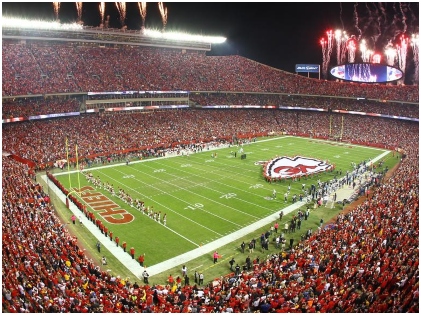
How the Largest Sports Teams Generate Huge Amounts of Money

Nothing unites our society as strongly and as unequivocally as a sport does. Sports have the unique ability to bring out our deepest emotions and unite us despite our many differences. No wonder competitive sport is one of the most lucrative businesses on the earth. There is not much else on this planet that can rival the sheer joy or the utter desolation that sports can simultaneously provide. Packed stadiums every week at live games bear testimony to the ever-enduring charm of competitive sport. With such a global demand, it is only natural for sports to be a billion-dollar industry. But where exactly does all the money come from? Here’s the answer.
Fan-Based Revenue
 It is a no-brainer that an industry that garners the attention of billions worldwide gets its lion’s share of the revenue from fans. Yes, you and every sport-loving individual around the world! Ticket sales bring in huge amounts of money to the industry because tickets to high-profile sporting events do not come cheap. If you want to catch the first-round singles match in the Centre Court at Wimbledon then you must be ready to shell out upwards of £1000 per person.
It is a no-brainer that an industry that garners the attention of billions worldwide gets its lion’s share of the revenue from fans. Yes, you and every sport-loving individual around the world! Ticket sales bring in huge amounts of money to the industry because tickets to high-profile sporting events do not come cheap. If you want to catch the first-round singles match in the Centre Court at Wimbledon then you must be ready to shell out upwards of £1000 per person.
UEFA Champions League Final ticket prices range from £70 to £400 or even higher depending on which teams make the final. It is not hard to imagine the revenue that ticket sales generate when you see packed stadiums at live games. For instance, NFL and NBA teams rake in astronomical amounts of money from ticket sales.
Merchandise Sales
 This is another form of fan-based revenue generation. Merchandises are hugely popular in any sport be it football, cricket, basketball, or tennis. It gives the fans a chance to connect deeply to the team or player they support and look up to. Merchandises also make for awesome gifts to any sports fanatic. Merchandises come in many forms such as jerseys, scarves, sports kits, miniature replicas, signed caps, or autographed balls and sell like hot cakes before live games.
This is another form of fan-based revenue generation. Merchandises are hugely popular in any sport be it football, cricket, basketball, or tennis. It gives the fans a chance to connect deeply to the team or player they support and look up to. Merchandises also make for awesome gifts to any sports fanatic. Merchandises come in many forms such as jerseys, scarves, sports kits, miniature replicas, signed caps, or autographed balls and sell like hot cakes before live games.
Simply by licensing deals to manufacture merchandise, a sports team can make money by doing almost nothing. World Wrestling Entertainment earns massive revenue from merchandise sales of its superstars and John Cena one of the highest earners in WWE makes millions from the sale of his merchandise (one of the most popular ones).
Sponsors
 Live sports are the single most popular option on television. The FIFA World Cup which takes place every four years commands a global audience of over 3 billion with the latest edition in 2014 amassing an astounding global viewership of 3.2 billion making it the most-watched live television event in history. Such a large consumer base is a gold mine for the advertising industry. Football and baseball teams have at least one sponsor providing financial support. This sponsor’s name is prominently displayed on the team’s jersey so that millions can see the brand name on television.
Live sports are the single most popular option on television. The FIFA World Cup which takes place every four years commands a global audience of over 3 billion with the latest edition in 2014 amassing an astounding global viewership of 3.2 billion making it the most-watched live television event in history. Such a large consumer base is a gold mine for the advertising industry. Football and baseball teams have at least one sponsor providing financial support. This sponsor’s name is prominently displayed on the team’s jersey so that millions can see the brand name on television.
Players, not to be left behind, have their sponsors who fund the player’s kits or even their outfits. In return, players promote the companies by sporting their products in live matches, training sessions, or at the gym. Roger Federer is sponsored by Rolex amongst others. In 2018 he signed a new deal with Uniqlo after his earlier contract with Nike ended.
The Transfer Market
 Transfers in big leagues usually involve enormous sums of money. Soccer transfers are the most widely followed and generate the largest revenue among all sports. Putting things in perspective, Brazilian footballer Neymar’s move from Barcelona to Paris Saint-Germain in 2017 was closed at €222 million. The second most expensive transfer is for Frenchman Kylian Mbappé to the same PSG team for €135 million. This is about 1.5 times less than what they paid for the Brazilian forward.
Transfers in big leagues usually involve enormous sums of money. Soccer transfers are the most widely followed and generate the largest revenue among all sports. Putting things in perspective, Brazilian footballer Neymar’s move from Barcelona to Paris Saint-Germain in 2017 was closed at €222 million. The second most expensive transfer is for Frenchman Kylian Mbappé to the same PSG team for €135 million. This is about 1.5 times less than what they paid for the Brazilian forward.
On the other hand, the most expensive transfer in basketball history is a mere €12.9 million. This was for Yao Ming’s move to CBA from Shanghai Sharks. Teams around the world invest the money they get from selling high profile players in advertisements and sponsorships. They also use this to rope in new and young players from the transfer market. A lot of intricacies are involved in a transfer deal. This includes the buyout clause, agent fees, and the mammoth fees of soccer players.
A big chunk of the money in sports comes from ardent supporters. Their passion and emotions for sport are the driving force of this multi-billion dollar industry. The revenue that comes in is often put back into the system to generate more profit. The rest is spent on paying employees, officials, and the somewhat ridiculous fees of the players.
More in money and fame
-
`
WWE SmackDown to Make a Comeback on USA Network in 2024
In a surprising twist, WWE’s Friday night staple, “SmackDown,” is bidding farewell to Fox and heading back to its old stomping...
November 24, 2023 -
`
Why Women Face Higher Out-of-Pocket Health Expenses
In healthcare, disparities persist, and a recent report from Deloitte underscores a significant financial gap between working women and men in...
November 18, 2023 -
`
Elon Musk vs Bill Gates: The Clash of Titans
In the realm of the world’s wealthiest individuals, a simmering rivalry has been captivating public attention. It’s not a clash of...
November 7, 2023 -
`
The Power Of Disconnecting
In our digitally driven age, where smartphones, tablets, and laptops have become extensions of ourselves, disconnecting might seem daunting. However, the...
October 31, 2023 -
`
JCPenney’s Bankruptcy: The End of an Era
JCPenney filed for bankruptcy in a move echoing the struggles of many retailers in the wake of the COVID-19 pandemic. This...
October 26, 2023 -
`
Reasons Why You Need a Financial Plan
Financial planning is not just for the wealthy or those nearing retirement. It’s a crucial tool for anyone seeking financial security...
October 19, 2023 -
`
How Brad Pitt Spends His Millions All Over the World
Brad Pitt, the charismatic Hollywood superstar, has left an indelible mark on the silver screen and made an impact in the...
October 10, 2023 -
`
Gen Z’s Posh Palate: The Unexpected Rise of Caviar Culture
Amid the backdrop of a digital era buzzing with viral dances, e-sports, and niche memes, there emerges a peculiar plot twist:...
October 7, 2023 -
`
Transform Your Retail Business With Social Media Mastery
If you’re a retail marketer posting your social media messages haphazardly, you might be missing out on prime opportunities to turn...
September 26, 2023















You must be logged in to post a comment Login